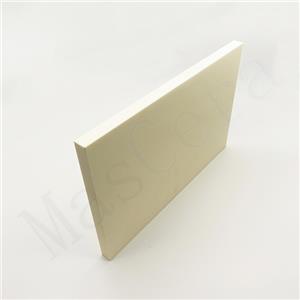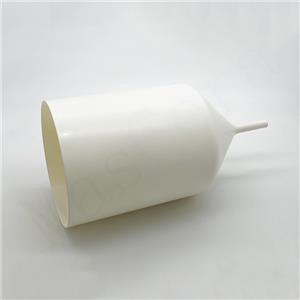Ceramic Bulletproof Series - Comparison of Main Ceramic Materials for Bulletproofing
The main ceramic materials that can be used as bulletproof materials are aluminum oxide, silicon carbide, boron carbide, silicon nitride, and titanium boride. Among them, aluminum oxide ceramics (Al2O3), silicon carbide ceramics (SiC), and boron carbide ceramics (B4C) are the most widely used. Aluminum oxide bulletproof ceramics have low hardness (HRA90) and high density compared to the other two, but are cheaper. Silicon carbide bulletproof ceramics have the highest hardness and best performance among the three, but are also far more expensive than the other two materials. The hardness of silicon carbide bulletproof ceramics can reach HRA92, and the density is only 82% of that of aluminum oxide bulletproof plates, with a moderate price and a more widely applied usage.
Aluminum oxide ceramics are a series of ceramic materials based on high-temperature aluminum oxide (α-Al2O3) as the main crystal phase, and α-Al2O3 is the only variant of Al2O3 that exists naturally in the world. It has the most compact structure, lowest reactivity, and best electrochemical properties among all variants and can remain stable at all temperatures.
Properties of aluminum oxide ceramic
| Al2O3 Property | Sintering |
| Density(g/cm3) | 3.6-3.95 |
| Flexural strength(Mpa) | 200-400 |
| Young's modulus(Gpa) | 300-450 |
| Fracture toughness(Mpa.m1/2) | 3.0-4.5 |
| Hardness(Gpa) | 12-18 |
Advantages: As the first-generation ceramic material in the bulletproof field, aluminum oxide is not only the strongest and hardest among all oxides, but also has good oxidation resistance, chemical inertness, and low cost, and is easy to obtain. In addition, sintered products are widely used in various armored vehicles and military and police bulletproof clothing because of their smooth surface, stable size, and low price.
Disadvantages: Low bending strength and fracture toughness, and low resistance to thermal shock. In addition, the performance of aluminum oxide varies greatly, mainly depending on process parameters, impurity content, particle size, and sintering temperature. At the same time, the high density of aluminum oxide cannot meet the trend of lightweight armor.
SiC has a unique crystal structure. Using one of the four carbon atoms as the center and silicon atoms as the paired atoms, one of the four outermost electrons is selected to pair with the outermost electron of the center carbon atom. By cyclic operation, the final structure is equivalent to the diamond tetrahedron structure composed of Si-C bonds, which exhibits extremely high hardness. At the same time, this structure has strong covalent bonds and high Si-C bond energy, making silicon carbide materials have the characteristics of high modulus, high hardness, and high specific strength.
Properties of silicon carbide ceramic under different sintering processes
| SIC Property | Hot-pressing sintering | Hot isostatic pressing | Reaction sintering | Spark plasma sintering |
| Density(g/cm3) | 3.25-3.28 | 3.01-3.13 | 3.02 | 3.12-3.20 |
| Flexural strength(Mpa) | 500-730 | 366-950 | 260 | 420-850 |
| Young's modulus(Gpa) | 440-450 | - | 359 | 420-460 |
| Fracture toughness(Mpa.m1/2) | 5.0-5.5 | 4.51-5.79 | 4.00 | 3.4-7.0 |
| Hardness(Gpa) | 20 | 10.5-20.0 | 17.23 | 19.8-32.7 |
Advantages: It is the most widely used non-oxide ceramic material with high hardness, second only to diamond, cubic nitride boron, and boron carbide. Due to its low density and high hardness, this ceramic is very suitable for ballistic protection, and is in the intermediate zone between aluminum oxide and boron carbide in terms of mechanical properties, density properties, ballistic properties, and application costs.
Disadvantages: The molecular structure and characteristics of silicon carbide determine its lower toughness. When hit by a bullet, its ultra-high strength can completely resist the huge kinetic energy of the bullet and instantly shatter the bullet, but it will also crack or even break into pieces at the moment of impact, which makes the silicon carbide ceramic plate only suitable for certain areas of bulletproofing. However, many researchers in the field of materials molecular science currently state that the low toughness of silicon carbide can be theoretically compensated for and overcome by controlling the sintering process and ceramic fiber preparation. This will greatly expand the application range of silicon carbide in the field of bulletproofing, making it an ideal material for manufacturing bulletproof equipment.
3.Boron Carbide ceramic
The Boron Carbide crystal belongs to the rhombohedral structure type. In its rhombohedral structure, each unit cell contains 15 atoms, of which 12 atoms (B11C) form a icosahedron, forming a spatial structure, while the remaining three atoms combine to form a C-B-C chain. The icosahedron is connected to the C-B-C chain through covalent bonds to form a relatively stable structure. At the same time, its constituent elements, carbon and boron, have very similar properties and atomic radii, resulting in B4C having some excellent properties that other non-oxide ceramics do not have.
Properties of Boron Carbide under different sintering processes
| B4C Property | Hot-pressing sintering | Hot isostatic pressing | Reaction sintering | Spark plasma sintering |
| Density(g/cm3) | 2.45-2.52 | 2.42-2.51 | 2.48-2.54 | 2.43-2.60 |
| Flexural strength(Mpa) | 200-500 | 365-627 | 235-321 | 607-627 |
| Young's modulus(Gpa) | 440-460 | 393-444 | 330-426 | 403-590 |
| Fracture toughness(Mpa.m1/2) | 2.0-4.7 | 2.4-3.3 | 4.1-4.4 | 2.8-5.8 |
| Hardness(Gpa) | 29-35 | 25-31 | 13.4-18.0 | 30.5-38.3 |
dvantages: Almost constant high-temperature hardness and good mechanical properties. At the same time, its density is the lowest among several commonly used armor ceramics, and its high elastic modulus makes it a good choice for military armor and space materials.
Disadvantages: Due to the highly covalent nature of the covalent bonds between boron and carbon atoms, its sintering is poor. Therefore, it is necessary to use high sintering temperatures very close to the material's melting point. These high temperatures lead to residual pores and subsequent grain spacing, which deteriorate the material's properties and performance. Therefore, hot pressing or hot isostatic pressing is usually used, which leads to higher manufacturing costs.




